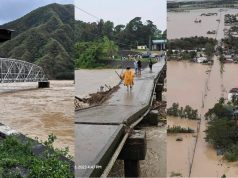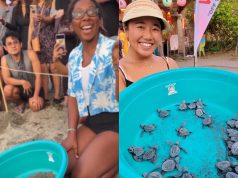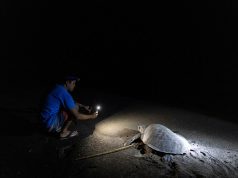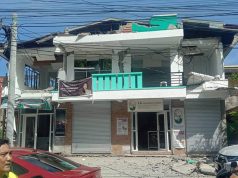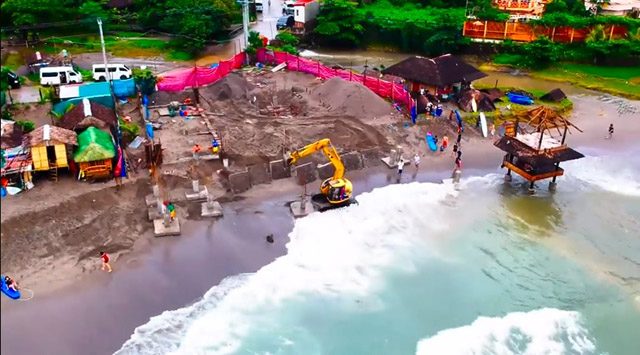
The pristine beach in San Juan, La Union, a surfing destination and home of the sea turtles, is under threat again after residents there found ongoing construction along the coast line.
Following the closure of Boracay island last April, La Union residents had sought to stop mass tourism and partying activities in their hometown to preserve it.
Calls rose online
Photos and videos of a structure being built near the coast line of the popular Urbiztondo beach in the town of San Juan in La Union circulated on social media recently.
El Union, a local coffee shop, expressed its concerns on Instagram on October 2, condemning it as the “ruin” of a beach and a wildlife habitat.
“This is how to ruin a beach, and eventually a surfable wave. But more importantly it is how to ruin a natural wildlife habitat for ancient sea creatures who help keep the ecosystem in balance,” El Union said in its caption.
Conservation group Coastal Underwater Resource Management Actions also shared a drone shot of the San Juan shore where a backhoe was excavating sand on Facebook.
In the video, the group detailed how the presence of heavy machinery poses a threat to the safety of beach-goers and to the endemic wildlife that live there.
When you build walls where walls are not meant to be then you alter the currents and the movement of sand. Sea turtles are dislocated by the altered landscape, too many people, too much noise and light, plus pollution. Decline of sea turtle population then will increase jellyfish population. Who wants to swim in jellyfish infested waters?If man alters the coastal landscape with no consideration for the impact on Nature, this will contribute to destruction. Marine life such as coastal plants, trees, and animals that have kept and maintained the balance of these areas will be destroyed.Nature has its own way to mitigate climate change and it has to do with the stability of coastal ecosystems. The coastal landscape is shaped by the ocean currents. The landscape along with the marine life (coastal vegetation and animals) are adapted to this environment. Because Nature has put them there, they are a part of the system that maintains its balance.It is hard to determine the exact location of salvage zones and the foreshore sites because we have moving sand dunes in San Juan. Sand dunes move from south to north during Habagat season. When there is a shift in wind direction during the cooler months of the year, the currents bring back the sands from the north to the south.This coincides with the sea turtle nesting season. That area where Panicsican Creek exits and the coastline going north are proven nesting sites. That is where 60 percent of turtle nests have been found by CURMA in the last 8 seasons. Other nesting sites are in Urbiztondo, Taboc, Ili Norte in San Juan.It's not even the natural habitat of man to live so close to the ocean. Instead of simply benefiting from that ecosystem and being its caretaker, Man is now disturbing this area. There will be no more tidal protection. The future of the whole area is compromised.We are destroying the very ecosystem that has kept us all alive and well. We are ruining the reason the coast is attracting tourism. There has to be a stop or we all suffer. May we ask the different agencies involved, both local and provincial, to please look into this. We must devote our best efforts to adhere to the preservation of nature.
Posted by Curma on Tuesday, October 2, 2018
CURMA told Interaksyon.com that a company called Green Portos Development Corporation was behind the construction activity.
This environmental situation prompted the regional DENR office in La Union to call the attention of San Juan Mayor Arturo P. Valdriz through a letter.
Valdriz soon heeded the concerns and issued a temporary halt order on the construction on October 3.
CURMA provided Interaksyon.com a screenshot of the letter that the local government issued to the private entity.
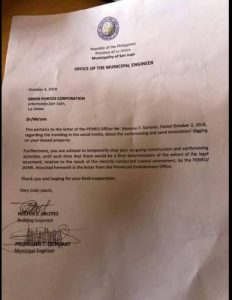
Nesting sites not clear
CURMA said in the video that the exact locations of the turtle nests are difficult to determine.
“Sand dunes move from south to north during Habagat season. When there is a shift in wind direction during the cooler months of the year, the currents bring back the sands from the north to the south,” it explained.
“That area where Panicsican Creek exits and the coastline going north are proven nesting sites. That is where 60 percent of turtle nests have been found by CURMA in the last 8 seasons. Other nesting sites are in Urbiztondo, Taboc, Ili Norte in San Juan,” it added.
Sea turtles should be protected, according to CURMA, because they regulate the number of jellyfishes in the beach.
It warned that the altered landscape will displace the sea turtles that nest in the area through the noise, lights, and especially pollution that the new structure offers.
“Decline of sea turtle population then will increase jellyfish population. Who wants to swim in jellyfish infested waters?” CURMA said.
In Article 51 of the Water Code of the Philippines, the banks of rivers, streams, seas and lakes within three meters in urban areas, twenty meters in agricultural area and forty meters in forest areas are only for public use only.
“No person shall be allowed to stay in this zone longer than what is necessary for recreation, navigation, flotage, fishing or salvage or to build structures of any kind.”
Vice Mayor Miko Magsaysay of San Juan shared on Facebook that there’s going to be a legislative session to identify the areas or boundaries where private businesses can be allowed to operate. —With Bea Celdran/Contributor




